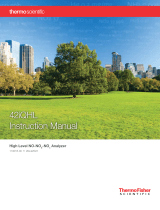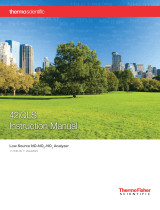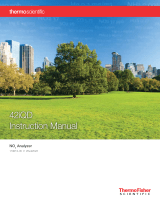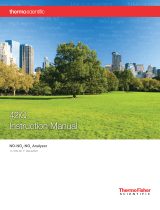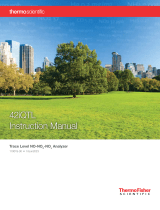Page is loading ...

Instruction Manual
748214-T
September 2002
http://www.processanalytic.com
Model 951C
NO
X
Analyzer

Emerson Process Management
Rosemount Analytical Inc.
Process Analytic Division
1201 N. Main St.
Orrville, OH 44667-0901
T (330) 682-9010
F (330) 684-4434
e-mail: [email protected]
http://www.processanalytic.com
ESSENTIAL INSTRUCTIONS
READ THIS PAGE BEFORE PROCEEDING!
Rosemount Analytical designs, manufactures and tests its products to meet many national and
international standards. Because these instruments are sophisticated technical products, you
MUST properly install, use, and maintain them to ensure they continue to operate within their
normal specifications. The following instructions MUST be adhered to and integrated into your
safety program when installing, using, and maintaining Rosemount Analytical products. Failure to
follow the proper instructions may cause any one of the following situations to occur: Loss of life;
personal injury; property damage; damage to this instrument; and warranty invalidation.
• Read all instructions prior to installing, operating, and servicing the product.
• If you do not understand any of the instructions, contact your Rosemount Analytical representative
for clarification.
• Follow all warnings, cautions, and instructions marked on and supplied with the product.
• Inform and educate your personnel in the proper installation, operation, and maintenance of
the product.
• Install your equipment as specified in the Installation Instructions of the appropriate
Instruction Manual and per applicable local and national codes. Connect all products to the
proper electrical and pressure sources.
• To ensure proper performance, use qualified personnel to install, operate, update, program, and
maintain the product.
• When replacement parts are required, ensure that qualified people use replacement parts specified by
Rosemount. Unauthorized parts and procedures can affect the product’s performance, place the safe
operation of your process at risk, and VOID YOUR WARRANTY. Look-alike substitutions may result
in fire, electrical hazards, or improper operation.
• Ensure that all equipment doors are closed and protective covers are in place, except when
maintenance is being performed by qualified persons, to prevent electrical shock and personal
injury.
The information contained in this document is subject to change without notice.
Teflon® is a registered trademark of E.I. duPont de Nemours and Co., Inc.
Alconox is a registered trademark of Alconox, Inc.
SNOOP® is a registered trademark of NUPRO Co.

Instruction Manual
748214-T
September 2002
Rosemount Analytical Inc. A Division of Emerson Process Management Contents i
Model 951C
TABLE OF CONTENTS
PREFACE...........................................................................................................................................P-1
Definitions ...........................................................................................................................................P-1
Safety Summary .................................................................................................................................P-2
General Precautions For Handling And Storing High Pressure Gas Cylinders .................................P-5
Documentation....................................................................................................................................P-6
Compliances .......................................................................................................................................P-6
Condensed Startup And Calibration Procedure .................................................................................P-7
1-0 DESCRIPTION AND SPECIFICATIONS..............................................................................1-1
1-1 Overview................................................................................................................................1-1
1-2 Typical Applications...............................................................................................................1-1
1-3 Specifications ........................................................................................................................1-2
2-0 INSTALLATION ....................................................................................................................2-1
2-1 Unpacking..............................................................................................................................2-1
2-2 location ..................................................................................................................................2-1
1-3 voltage requirements .............................................................................................................2-1
1-4 Electrical Connections ...........................................................................................................2-1
a. Line Power Connections .................................................................................................2-1
b. Potentiometric Recorder Connections ............................................................................2-3
c. Current Recorder Connections .......................................................................................2-3
1-5 Gas Requirements.................................................................................................................2-5
a. Air (U.S.P. Breathing Grade) ..........................................................................................2-5
b. Span Gas ........................................................................................................................2-5
1-6 Sample Requirements ...........................................................................................................2-5
1-7 Gas Connections ...................................................................................................................2-5
1-8 Leak Test ...............................................................................................................................2-6
3-0 OPERATION .........................................................................................................................3-1
3-1 Front Panel Indicators and Controls......................................................................................3-1
a. Display ............................................................................................................................3-1
b. Range Selection..............................................................................................................3-1
c. Sample Pressure Gauge.................................................................................................3-1
d. Ozone Pressure ..............................................................................................................3-1
e. Zero and Span Potentiometers .......................................................................................3-2
f. Ozone Interlock ...............................................................................................................3-2
3-2 Startup Procedure .................................................................................................................3-3
3-3 Calibration..............................................................................................................................3-6
a. Zero Calibration...............................................................................................................3-6
b. Upscale Calibration.........................................................................................................3-6
3-4 Routine Operation .................................................................................................................3-6
3-5 Converter Temperature Adjustment Procedure ....................................................................3-6
3-6 Measurement of Converter Efficiency ...................................................................................3-8
3-7 Recommended Calibration Frequency..................................................................................3-8

Instruction Manual
748214-T
September 2002
ii Contents Rosemount Analytical Inc. A Division of Emerson Process Management
Model 951C
4-0 THEORY................................................................................................................................4-1
4-1 Nitric Oxide Determination by Chemiluminescence Method .................................................4-1
4-2 Analyzer Flow System ...........................................................................................................4-1
a. Flow of Sample, Standard Gas or Zero Gas to Reaction Chamber ...............................4-1
b. Ozone Generation...........................................................................................................4-1
4-3 Signal Conditioning And Display ...........................................................................................4-2
a. Circuit Functions .............................................................................................................4-2
4-4 Analyzer Thermal System .....................................................................................................4-3
5-0 ROUTINE SERVICING..........................................................................................................5-1
5-1 System Checks and Adjustments..........................................................................................5-1
a. Display Fullscale Span Adjustment.................................................................................5-1
b. Overall Sensitivity............................................................................................................5-1
c. Ozone Output..................................................................................................................5-2
d. Background Current........................................................................................................5-2
5-2 Servicing Flow System ..........................................................................................................5-2
a. Cleaning Sample Capillary..............................................................................................5-3
b. Ozone Restrictor Fitting ..................................................................................................5-3
5-3 Photomultiplier Tube/Reaction Chamber ..............................................................................5-3
a. Removal ..........................................................................................................................5-4
b. Cleaning Reaction Chamber...........................................................................................5-4
c. Photomultiplier Tube and Housing..................................................................................5-5
d. Replacement of Photomultiplier Tube.............................................................................5-5
5-4 Ozone Generation System ....................................................................................................5-6
a. Lamp/Housing Removal..................................................................................................5-6
b. UV Lamp Replacement...................................................................................................5-6
c. Power Supply Removal...................................................................................................5-7
5-5 Converter Assembly ..............................................................................................................5-7
5-6 Servicing Electronic Circuitry.................................................................................................5-7
6-0 REPLACEMENT PARTS ......................................................................................................6-1
6-1 Matrix .....................................................................................................................................6-1
6-2 Circuit Board Replacement Policy .........................................................................................6-2
6-3 Replacement Parts ................................................................................................................6-2
a. Common Parts ................................................................................................................6-2
b. Photomultiplier Assembly 654062...................................................................................6-4
c. Converter Assembly 654070...........................................................................................6-5
d. Temperature Control Assembly 654068 .........................................................................6-6
7-0 RETURN OF MATERIAL ......................................................................................................7-1
7-1 return of material ...................................................................................................................7-1
7-2 customer service ...................................................................................................................7-1
7-3 Training..................................................................................................................................7-1
8-0 INDEX....................................................................................................................................8-1

Instruction Manual
748214-T
September 2002
Rosemount Analytical Inc. A Division of Emerson Process Management Contents iii
Model 951C
LIST OF ILLUSTRATIONS
Figure 2-1. Power Supply Board Voltage Select Switches ...................................................... 2-2
Figure 2-2. Temperature Control Board ................................................................................... 2-2
Figure 2-3. Cable Gland........................................................................................................... 2-3
Figure 2-4. Rear View of Model 951C (cover removed) .......................................................... 2-4
Figure 2-5. Rear Panel Wiring Connections............................................................................. 2-4
Figure 3-1. Model 951C Controls, Indicators and Adjustments ............................................... 3-1
Figure 3-2. Signal Board .......................................................................................................... 3-2
Figure 3-3. Signal Board Test Points ....................................................................................... 3-2
Figure 3-4. Signal Board Diagnostic Jumpers ......................................................................... 3-2
Figure 3-5. Hi/Lo Range Select Jumper................................................................................... 3-3
Figure 3-6. PPM Range Select Switch..................................................................................... 3-3
Figure 3-7. Decimal Point Select Jumpers............................................................................... 3-3
Figure 3-8. Range 2 Selection Jumpers................................................................................... 3-3
Figure 3-9. Power Supply Board .............................................................................................. 3-5
Figure 4-1. Analyzer Signal Conditioning Circuit ..................................................................... 4-4
Figure 4-2. Analyzer Thermal System...................................................................................... 4-5
Figure 6-1. Major Assemblies of the Model 951C.................................................................... 6-3
Figure 6-2. Photomultiplier Housing Assembly ........................................................................ 6-4
Figure 6-3. Converter Assembly .............................................................................................. 6-5
Figure 6-4. Case Heater Temperature Control Assembly........................................................ 6-6
LIST OF TABLES
Table 3-1. Resistance of Converter Temperature Sensor vs. Temperature .....................................3-7
DRAWINGS
(LOCATED IN REAR OF MANUAL)
654063 Installation Drawing
654090 Flow Diagram, Lo Range
654093 Flow Diagram, Hi Range
661246 Schematic Diagram, Signal/Control Board

Instruction Manual
748214-T
September 2002
iv Contents Rosemount Analytical Inc. A Division of Emerson Process Management
Model 951C

Instruction Manual
748214-T
September 2002
Rosemount Analytical Inc. A Division of Emerson Process Management Preface P-1
Model 951C
PREFACE
The purpose of this manual is to provide information concerning the components,
functions, installation and maintenance of the 951C NO
X
Analyzer.
Some sections may describe equipment not used in your configuration. The user should
become thoroughly familiar with the operation of this module before operating it. Read
this instruction manual completely.
DEFINITIONS
The following definitions apply to DANGERS, WARNINGS, CAUTIONS and NOTES found throughout
this publication.
DANGER .
Highlights the presence of a hazard which will cause severe personal injury, death, or substantial
property damage if the warning is ignored.
WARNING .
Highlights an operation or maintenance procedure, practice, condition, statement, etc. If not
strictly observed, could result in injury, death, or long-term health hazards of personnel.
CAUTION.
Highlights an operation or maintenance procedure, practice, condition, statement, etc. If not
strictly observed, could result in damage to or destruction of equipment, or loss of effectiveness.
NOTE
Highlights an essential operating procedure,
condition or statement.

Instruction Manual
748214-T
September 2002
P-2 Preface Rosemount Analytical Inc. A Division of Emerson Process Management
Model 951C
SAFETY SUMMARY
If this equipment is used in a manner not specified in these instructions, protective systems may be
impaired.
AUTHORIZED PERSONNEL
To avoid explosion, loss of life, personal injury and damage to this equipment and on-site
property, all personnel authorized to install, operate and service the this equipment should be
thoroughly familiar with and strictly follow the instructions in this manual. SAVE THESE
INSTRUCTIONS.
DANGER.
ELECTRICAL SHOCK HAZARD
Do not operate without doors and covers secure. Servicing requires access to live parts which can
cause death or serious injury. Refer servicing to qualified personnel.
This instrument was shipped from factory set up to operate on 115 volt 50/60 Hz. For operation on
230 volt 50/60 Hz, refer to Section 2-3.
For safety and proper performance this instrument must be connected to a properly grounded
three-wire source of power.
WARNING
INTERNAL ULTRAVIOLET LIGHT HAZARD
Ultraviolet light from the ozone generator can cause permanent eye damage. Do not look directly at
the ultraviolet source in ozone generator. Use of ultraviolet filtering glasses is recommended.

Instruction Manual
748214-T
September 2002
Rosemount Analytical Inc. A Division of Emerson Process Management Preface P-3
Model 951C
WARNING
TOXIC CHEMICAL HAZARD
This instrument generates ozone which is toxic by inhalation and is a strong irritant to throat and
lungs. Ozone is also a strong oxidizing agent. Its presence is detected by a characteristic pungent
odor.
The instrument exhaust contains both ozone and nitrogen dioxide, both toxic by inhalation, and
may contain other constituents of the sample gas which may be toxic. Such gases include various
oxides of nitrogen, unburned hydrocarbons, carbon monoxide and other products of combustion
reactions. Carbon monoxide is highly toxic and can cause headache, nausea, loss of
consciousness, and death.
Avoid inhalation of the ozone produced within the analyzer and avoid inhalation of the sample and
exhaust products transported within the analyzer. Avoid inhalation of the combined exhaust
products at the exhaust fitting.
Keep all tube fittings tight to avoid leaks. See Section 2-8 for Leak Test Procedure.
Connect rear exhaust outlet to outside vent by a 1/4 inch (6.3 mm) or larger stainless steel or Teflon
line. Check vent line and connections for leakage.
WARNING .
PARTS INTEGRITY
Tampering or unauthorized substitution of components may adversely affect safety of this product.
Use only factory documented components for repair.
WARNING.
HIGH PRESSURE GAS CYLINDERS
This instrument requires periodic calibration with a known standard gas. See Sections 2-5 and 3-3.
See also General Precautions for Handling and Storing High Pressure Gas Cylinders, page P-5.

Instruction Manual
748214-T
September 2002
P-4 Preface Rosemount Analytical Inc. A Division of Emerson Process Management
Model 951C
WARNING.
TOXIC AND OXIDIZING GAS HAZARD
The ozone generator lamp contains mercury. Lamp breakage could result in mercury exposure.
Mercury is highly toxic if absorbed through skin or ingested, or if vapors are inhaled.
HANDLE LAMP ASSEMBLY WITH EXTREME CARE
If lamp is broken, avoid skin contact and inhalation in the area of the lamp or the mercury spill.
•
Immediately clean up and dispose of the mercury spill and lamp residue as follows:
•
Wearing rubber gloves and goggles, collect all droplets of mercury by means of a suction pump
and aspirator bottle with long capillary tube. Alternatively, a commercially available mercury
spill clean-up kit, such as J. T. Baker product No. 4439-01, is recommended.
•
Carefully sweep any remaining mercury and lamp debris into a dust pan. Carefully transfer all
mercury, lamp residue and debris into a plastic bottle which can be tightly capped. Label and
return to hazardous material reclamation center.
•
Do not place in trash, incinerate or flush down sewer.
•
Cover any fine droplets of mercury in non-accessible crevices with calcium polysulfide and
sulfur dust.
WARNING.
TOPPLING HAZARD
This instrument’s internal pullout chassis is equipped with a safety stop latch located on the left
side of the chassis.
When extracting the chassis, verify that the safety latch is in its proper (counter-clockwise)
orientation.
If access to the rear of the chassis is required, the safety stop may be overridden by lifting the
latch; however, further extraction must be done very carefully to insure the chassis does not fall
out of its enclosure.
If the instrument is located on top of a table or bench near the edge, and the chassis is extracted, it
must be supported to prevent toppling.
Failure to observe these precautions could result in personal injury and/or damage to the product.

Instruction Manual
748214-T
September 2002
Rosemount Analytical Inc. A Division of Emerson Process Management Preface P-5
Model 951C
GENERAL PRECAUTIONS FOR HANDLING AND STORING HIGH
PRESSURE GAS CYLINDERS
Edited from selected paragraphs of the Compressed Gas Association's "Handbook of Compressed
Gases" published in 1981
Compressed Gas Association
1235 Jefferson Davis Highway
Arlington, Virginia 22202
Used by Permission
1. Never drop cylinders or permit them to strike each other violently.
2. Cylinders may be stored in the open, but in such cases, should be protected against extremes of weather
and, to prevent rusting, from the dampness of the ground. Cylinders should be stored in the shade when
located in areas where extreme temperatures are prevalent.
3. The valve protection cap should be left on each cylinder until it has been secured against a wall or bench, or
placed in a cylinder stand, and is ready to be used.
4. Avoid dragging, rolling, or sliding cylinders, even for a short distance; they should be moved by using a
suitable hand-truck.
5. Never tamper with safety devices in valves or cylinders.
6. Do not store full and empty cylinders together. Serious suckback can occur when an empty cylinder is
attached to a pressurized system.
7. No part of cylinder should be subjected to a temperature higher than 125
°
F (52
°
C). A flame should never be
permitted to come in contact with any part of a compressed gas cylinder.
8. Do not place cylinders where they may become part of an electric circuit. When electric arc welding,
precautions must be taken to prevent striking an arc against the cylinder.

Instruction Manual
748214-T
September 2002
P-6 Preface Rosemount Analytical Inc. A Division of Emerson Process Management
Model 951C
DOCUMENTATION
The following 951C instruction materials are available. Contact Customer Service Center or the local
representative to order.
748214 Instruction Manual (this document)
COMPLIANCES
This product satisfies all obligations of all relevant standards of the EMC framework in Australia and New
Zealand.
N
9
6

Instruction Manual
748214-T
September 2002
Rosemount Analytical Inc. A Division of Emerson Process Management Preface P-7
Model 951C
CONDENSED STARTUP AND CALIBRATION PROCEDURE
The following summarized instructions on
startup and calibration are intended for
operators already familiar with the analyzer.
For initial startup, refer to detailed instructions
provided in Section 3.
1. Set Range switch on the Signal Board to
position 4, 250 ppm (see Figure 3-2, page 3-
2).
2. Verify that Hi/Lo Range Jumper is installed
for Hi Range (Figure 3-5, page 3-3)
3. Apply power to the analyzer. The analyzer
will now require approximately one to two
hours for temperature equilibrium before
being ready for calibration.
4. Verify that the pressure regulator on the
cylinder of zero gas (nitrogen or air) or
sample gas is set for supply pressure of 10
to 17 psig.
5. Verify that the pressure regulator on the
cylinder of air (ozonator supply) is set for
supply pressure of 20 to 25 psig.
6. Establish correct pressure of sample gas:
a. Supply sample gas to rear-panel
SAMPLE inlet at 10 to 17 psig (normally
15 psig).
b. Adjust SAMPLE Back Pressure
Regulator so that SAMPLE Pressure
Gauge indicates the value appropriate to
the desired operating range (normal
operating pressure is 3 to 5 psig). See
Figure 3-1.
7. Establish correct pressure of zero gas:
a. Supply zero gas to rear panel SAMPLE
inlet and set to 15 psig.
b. Note reading on SAMPLE Pressure
Gauge. It should be the same as in Step
6b. If not, adjust output pressure
regulator on the zero gas cylinder as
required.
7. Establish correct pressure of upscale
standard gas:
a. Supply upscale standard gas to rear
panel SAMPLE inlet.
b. Note reading on SAMPLE Pressure
Gauge. It should be the same as in
Step 7b. If not, adjust output
regulator on cylinder of upscale
standard gas as required.
NOTE
Supply pressure for sample, upscale
standard gas and zero air must be the
same. If not, the readout will be in error.
8. Zero Calibration:
a. Set PPM RANGE Switch (Figure
3-6, page 3-3) for range to be used
for sample analysis. Set the front
panel RANGE1 Control at normal
operating setting, if known, or at
about mid-range if normal setting is
not known.
b. Supply zero gas to rear panel
SAMPLE inlet.
c. Adjust front panel ZERO Control for
reading of zero on meter or recorder.
9. Upscale Calibration:
a. Set PPM RANGE Switch (Figure
3-6, page 3-3) at setting appropriate
to the particular span gas.
b. Supply upscale standard gas of
accurately known NO
X
content to
rear panel SAMPLE inlet.
c. Adjust front panel RANGE1 Control
so that reading on meter or recorder
is equal to the know parts-per-million
concentration of NO
X
in the span
gas.

Instruction Manual
748214-T
September 2002
P-8 Preface Rosemount Analytical Inc. A Division of Emerson Process Management
Model 951C
NOTE
It is the responsibility of the user to measure
efficiency of the NO
2
-to-NO converter during
initial startup, and thereafter at intervals
appropriate to the application, normally
once a month.

Instruction Manual
748214-T
September 2002
Rosemount Analytical Inc. A Division of Emerson Process Management Installation 1-1
Model 951C
SECTION 1
DESCRIPTION AND SPECIFICATIONS
1-1 OVERVIEW
The Model 951C NO
X
Analyzer is designed to
measure NO
X
using one of two sets of ranges
designated as Hi or Lo. The Hi Range set
consists of spans with ranges of 0-100, 0-250,
0-1000, and 0-2500 ppm NO
X
. The Lo Range
set consists of spans with ranges of 0-10, 0-25,
0-100, and 0-250 ppm NO
X
.
The NO
X
analyzer continuously analyzes a
flowing gas sample for NO
X
[nitric oxide (NO)
plus nitrogen dioxide (NO
2
)]. The sum of the
concentrations is continuously reported as NO
X
.
The analyzer is based on the
chemiluminescence method of NO detection.
The sample is continuously passed through a
heated bed of vitreous carbon, in which NO
2 is
reduced to NO. Any NO initially present in the
sample passes through the converter
unchanged, and any NO
2
is converted to an
approximately equivalent (95%) amount of NO.
The NO is quantitatively converted to NO
2 by
gas-phase oxidation with molecular ozone
produced within the analyzer from air supplied
by an external cylinder. During this reaction,
approximately 10% of the NO
2
molecules are
elevated to an electronically excited state,
followed by immediate decay to the non-excited
state, accompanied by emission of photons.
These photons are detected by a photomultiplier
tube, which in turn generates a DC current
proportional to the concentration of NO
X
in the
sample stream. The current is then amplified
and used to drive a front panel display and to
provide potentiometric and isolated current
outputs.
To minimize system response time, an internal
sample-bypass feature provides high-velocity
sample flow through the analyzer.
The display blinks when the analyzer is 10% or
more over-range. Selecting a less sensitive
(higher) range restores the display function.
The case heater assembly of the Model
951C maintains the internal temperature at
approximately 50
o
C (122
o
F).
1-2 TYPICAL APPLICATIONS
The Model 951C Analyzer has specific
applications in the following areas:
• Oxides of nitrogen (NO
X
) emissions
from the combustion of fossil fuels in:
• Vehicle engine exhaust
• Incinerators
• Boilers
• Gas appliances
• Turbine exhaust
• Nitric acid plant emissions
• Ammonia in pollution control
equipment (with converter)
• Nitric oxide emissions from decaying
organic material (i.e., landfills).

Instruction Manual
748214-T
September 2002
Description and Specifications Rosemount Analytical Inc. A Division of Emerson Process Management
1-2
Model 951C
1-3 SPECIFICATIONS
Ranges
L
O
........................................... 0 to 10, 0 to 25, 0 to 100, 0 to 250 ppm NO
X
H
I
........................................... 0 to 100, 0 to 250, 0 to 1000, 0 to 2500 ppm NO
X
Repeatability.................................. within 0.1 ppm or ±1% of fullscale, whichever is greater
Zero/Span Drift .............................. less than ±0.1 ppm or ±1% of fullscale, whichever is greater, in 24
hours at constant temperature
less than ±0.2 ppm or ±2% of fullscale, whichever is greater, over
any 10°C interval from 4 to 40°C (for rate change of 10°C or less
per hour)
Response Time
(Electronic + Flow)
................ 90% of fullscale in less than 1 minute
Sensitivity ...................................... less than 0.1 ppm or 1% of fullscale, whichever is greater
Detector Operating Pressure......... atmospheric
Total Sample Flow Rate ................ 1 Liter per minute at 20 psig
Sample Pressure........................... 138 kPa (20 psig)
Ozone Generator Gas ................... U.S.P. breathing-grade air
Ambient Temperature Range........ 4 to 40°C (40 to 104°F)
Analog Output
Potentiometric........................ 0 to +5 VDC, 2000 ohm minimum load
Isolated Current ..................... Field-selectable 0 to 20 or 4 to 20 mA, 700 ohm max load
Display ................................... Digital, 4-1/2 digit LCD, readout in engineering units, back-lighted
Power Requirements..................... 115/230 VAC ±10%, 50/60 ±3 Hz, 570 W maximum
Enclosure....................................... General purpose for installation in weather-protected areas
Dimensions.................................... 8.7 in. x 19.0 x 19.0 in. (H x W x D)
22.0 cm x 48.3 cm x 48.3 cm (H x W x D)
Weight ........................................... 22.2 kg (49 lbs) approximate

Instruction Manual
748214-T
September 2002
Rosemount Analytical Inc. A Division of Emerson Process Management Installation 2-1
Model 951C
SECTION 2
INSTALLATION
2-1 UNPACKING
Carefully examine the shipping carton and
contents for signs of damage. Immediately
notify the shipping carrier if the carton or its
contents are damaged. Retain the carton and
packing material until the instrument is
operational.
2-2 LOCATION
See drawing 654063 for Outline and Mounting
dimensions.
Install analyzer in a clean area, free from
moisture and excessive vibration, at a stable
temperature within 4 to 40°C.
The analyzer should be mounted near the
sample source to minimize sample-transport
time.
A temperature control system maintains the
internal temperature of analyzer at 50°C (122°F)
to ensure proper operation over an ambient
temperature range of 4°C to 40°C (40°F to
110°F). Temperatures outside these limits
necessitate use of special
temperature-controlling equipment or
environmental protection. Also, the ambient
temperature should not change at a rate
exceeding 10°C/hr.
The cylinders of air and span gas should be
located in an area of constant ambient
temperature (±10°C).
2-3 VOLTAGE REQUIREMENTS
WARNING
ELECTRICAL SHOCK HAZARD
For safety and proper performance this
instrument must be connected to a properly
grounded three-wire source of power.
This instrument was shipped from the factory
set up to operate on 115 VAC, 50/60 Hz electric
power. For operation on 230 VAC, 50/60 Hz, on
the Power Supply Board (Figure 3-9, page 3-5)
position voltage select switches S1, S2, S3
(Figure 2-1, page 2-2) and S3 (located on the
Temperature Control Board (Figure 2-2, page 2-
2) in the 230 VAC position.
Refer to Figure 2-4, page 2-3. On the rear of the
analyzer, remove the 6.25 A fuse (P/N 902413)
and replace with the 3.15 A fuse (P/N 898587)
provided in the shipping kit.
2-4 ELECTRICAL CONNECTIONS
The power and output (recorder and current)
cable glands are supplied loose in the shipping
kit to allow cable installation to connectors or
terminal strips.
Cable
Gland Part No.
Power 899330
Recorder 899329
Remove rear cover to access terminals. Route
each cable through the cable gland and connect
to the appropriate connector or terminal strip,
tighten the gland.
a. Line Power Connections
Refer to Figure 2-3 (page 2-3), Figure 2-4
(page 2-3), Figure 2-5 (page 2-4) and
drawing 654063. If this instrument is
located on a bench or table top or is
installed in a protected rack, panel or
cabinet, power may be connected via a
3-wire flexible power cord, minimum 18
AWG (max. O.D. 0.480", min. O./D. 0.270"),
through the hole labeled POWER, utilizing
connector gland (P/N 899330) provided.
Route the power cable through the cable
gland and connect the leads to TB1 on the
rear panel. Tighten the cable gland
adequately to prevent rotation or slippage of
the power cable. Since the rear terminals do

Instruction Manual
748214-T
September 2002
2-2 Installation Rosemount Analytical Inc. A Division of Emerson Process Management
Model 951C
Set switch window for voltage required.
not slide out with the chassis, no excess
power cable slack is necessary.
The following power cord and/or support
feet (for bench top use) are available:
•
Power Cord 634061
•
North American power cord set (10 foot)
•
Enclosure Support Kit 634958
•
Enclosure support feet (4)
•
Power Cord/Enclosure Support Kit
654008
•
North American power cord set (10 foot)
•
Enclosure support feet (4)
If the instrument is permanently mounted in
an open panel or rack, use electrical metal
tubing or conduit.
Figure 2-1. Power Supply Board Voltage Select Switches
Figure 2-2. Temperature Control Board
S3
Set switch window for voltage required.

Instruction Manual
748214-T
September 2002
Rosemount Analytical Inc. A Division of Emerson Process Management Installation 2-3
Model 951C
EXHAUST
AIR
IN
20 PSI (138 kPa)
NOMINAL
RECORDER
OUTPUT
POWER
+ -
G
+ -
CUR
OUTPUT
VOLT
OUTPUT
L1/HOT
L2/NEUT
GND
SAMPLE
IN
10 PSI - 17 PSI
(70 kPa - 120 kPa)
FUSE
RANGE 1
RANGE 2
RANGE 3
RANGE 4
RTN
RTN
+24 VDC IN
+24 VDC IN
CHS GND
CHS GND
See Figure 2-5 for
connections
Fuse
b. Potentiometric Recorder Connections
Refer to Figure 2-3 (below), Figure 2-5
(page 2-4) and drawing 654063.
Potentiometric recorder connections are
made on the rear panel. Route the
potentiometric recorder cable through the
cable gland in the hole labeled
RECORDER OUTPUT and connect to
VOLT OUTPUT terminals.
Potentiometric recorder cable specifications
are as follows:
•
Distance from recorder to analyzer:
1000 feet (305 meters) maximum
•
Input impedance: Greater than 2000
ohms
• Cable (user supplied): Two-conductor,
shielded, min. 20 AWG
•
Voltage output: 0 to +5 VDC
c. Current Recorder Connections
Refer to Figure 2-3 (below), Figure 2-5
(page 2-4) and drawing 654063. Current
recorder connections are made on the rear
panel. Route the current recorder cable
through the cable gland in the hole labeled
RECORDER OUTPUT and connect to CUR
OUTPUT terminals
Current recorder interconnection cable
specs are as follows:
•
Distance the recorder from
analyzer: 3000 feet (915
meters).maximum
•
Load resistance: Less than 700
Ohms.
•
Cable (user supplied):
Two-conductor, shielded, min. 20
AWG
As supplied by the factory, the current
output produces a zero of 4 mA. The
current output may be adjusted to
produce a zero of 0 mA as follows:
1. Zero the instrument as in Section 3-
4. Adjust R23, the zero-adjust
potentiometer on the Power Supply
Board, to produce 0 mA current
output.
Figure 2-3. Cable Gland
Figure 2-4. Rear View of Model 951C (cover removed)
Case Wall
Cable
Nut Gland Nut
INTERIOR EXTERIOR

Instruction Manual
748214-T
September 2002
2-4 Installation Rosemount Analytical Inc. A Division of Emerson Process Management
Model 951C
Figure 2-5. Rear Panel Wiring Connections
RECORDER
OUTPUT
POWER
+ -
G
+ -
CUR
OUTPUT
VOLT
OUTPUT
L1/HOT
L2/NEUT
GND
FUSE
RANGE 1
RANGE
2
RANGE
3
RANGE
4
RTN
RTN
+24 VDC IN
+24 VDC IN
CHS GN
D
CHS GN
D
TB1
TB2
J2
J2
Remote Range Change
Connections
TB1
AC Power Connections
TB2
Recorder Connections
TB2
Current Output Connections
/
